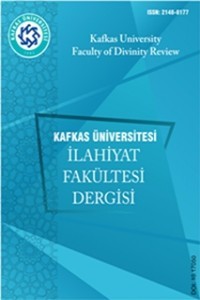Arapça Öğretiminde Kuranı kerimi Kullanılması
Makale, Arap olmayanlar hakkında Arapça eğitiminde karşılaşılan en önemli sorunlardan birini ele almaktadır. Bu sorun Arapça öğreniminde öğrencilere sunulan kitap setleriyle ilgilidir. Bunun yanı sıra çalışmada dolaylı yoldan Arapça’nın yeni Arapça ile bağlantısı olmayan eski ve yeni Arapça şeklinde ikiye ayrılması hatasına da dikkat çekilmiştir. Arapça asla böyle bir ayrımı kabul etmemektedir. Çalışmada lügavî, nahvî ve sarf açısından örnek olarak seçilen ayetler son derece önemlidir. Bu örnekler bize Arapça’nın sabit olduğunu ve hala devam ettiğini göstermektedir. Arapça öğrenenlerin büyük çoğunluğu Kur’ân’ı ve hadisleri anlamayı hedeflemektedir. Bu çalışma Arapça eğitiminde ilk aşamada en büyük görevin ayetlere ve hadislere yüklendiği bir eğitim metoduna öneri ve hazırlık amacıyla hazırlanmıştır. Önerilen bu metotla öğrenciler daha kısa bir yolla hem hedeflerine ulaşabilecekler hem de asıl amaç olan Arapça’yı kullanarak iletişim kurabileceklerdir.
Arapça eğitiminde karşılaşılan sorunlar arasında çalışmanın ele aldığı problem öğrenciler için hazırlanan setlerdir. Söz konusu setlerde lafızlar ve cümle yapıları konusunda zenginliğine ve içerdiği manalara rağmen Kur’ân’a çok az başvurulmaktadır. Bu setlerin büyük çoğunluğunda Kur’ân’da bulunmayan kelimeler kullanılmakta ve yine Kur’ân’daki önemli birçok nahvî yapılara yoğunlaşılmamaktadır.
Benefiting from the Qur'an in Teaching Arabic to Foreigners
The researcher tries to study one of the most important challenges facing the teaching of the Arabic language to non-native speakers, and this challenge is related to the chains that are presented to the learners of the Arabic language other than its children, and on the other hand and indirectly, the researcher proves the error of dividing the Arabic language into two ancient, dead, and contemporary languages that are not of ancient Arabic. On the one hand, as this division is not suitable for the Arabic language at all, the choices that the researcher made from the Noble Qur’an are not a few, but rather very important, linguistically, grammatically and morphologically.It proves the stability and continuity of the Arabic language, and this research comes as an attempt to pave the way for a greater employment of Quranic or prophetic religious texts in the series of the first stages of language education for non-children, who for the most part study the Arabic language to understand the Qur’an and the Sunnah of the Prophet. The main aspect of language learning is communication. The problem begins with the Arabic language chains, as they rarely resort to the Noble Qur’an and benefit from its words and structures, despite its richness and ability to cover a great deal of sensory and non-sensory meanings, but most of the chains replace words not mentioned in the Holy Qur’an, or do not focus on important grammatical structures in it.
Keywords:
Quran, Arabic language, education.,
___
- 1. Enîs, İbrâhim. min Esrâri’l-Luğ. Mektebetü Anclû-Mısrıyye. 6. Baskı, Mısır. 1978. 2. Bedevî Saîd, Muhammed. Müsteviyâti’l-Arabiyyeti’l-Muâsırati fî Mısır, Dâru’l-Meârif. Mısır. 1973.
- ISSN: 2148-8177
- Yayın Aralığı: Yılda 2 Sayı
- Başlangıç: 2014
- Yayıncı: Kafkas Üniversitesi
Sayıdaki Diğer Makaleler
İslâm Kültür Geleneğinde “Savâdu’l-A’zâm”
Meşrutiyet Dönemi Aydınlarında İslamcılık Tartışmaları
Arapça Öğretiminde Kuranı kerimi Kullanılması
Post modern Toplum Algısında Din Kurumu ve Toplumsal Bütünleşmeye Dair Beklentiler
Aruza Dair Didaktik Bir Manzûme: Yusuf en-Nebhânî’nin Medh-i Nebîsi
el-Hâl et-Tâlevî'nin Şiirindeki Sanatsal İmge (Analitik ve Eleştirel Araştırma)
Muhammed HAMİDO, Akeel SHAWAKH MOHAMAD
Niyâzî-i Mısrî ve Yaşadığı Dönemin Özellikleri
Bâbil Hukuk Kuralları ve Yahudilik
